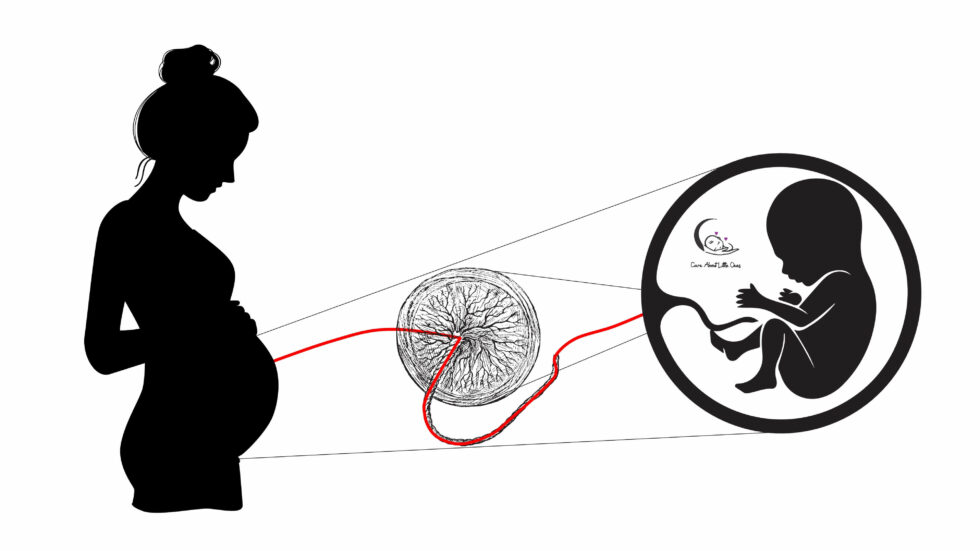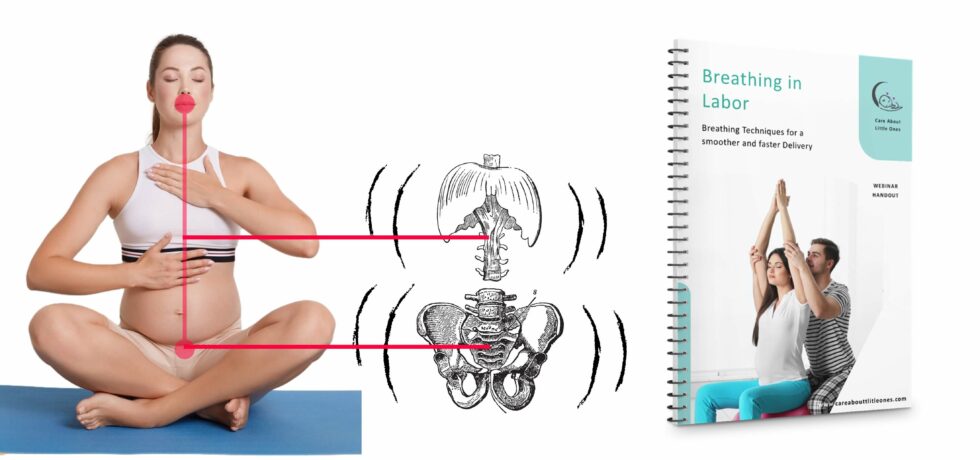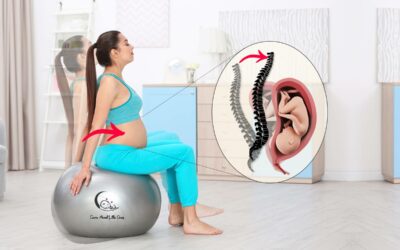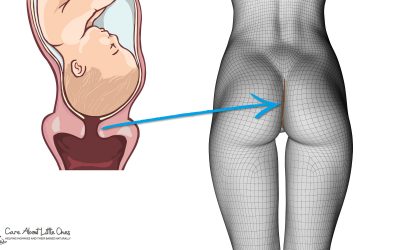How to increase the Oxygen Supply to the Baby in the Womb

During your pregnancy, there is a constant supply of oxygen to your baby. But what pregnant women often don’t know is that there are certain things that can reduce the oxygen supply to the baby. Luckily though, there are also very simple ways to increase the oxygen supply to the baby in the womb.
So, how can you increase the oxygen supply to the baby?
The key to increase the oxygen supply to the baby is to maintain a good blood circulation, as well as a good oxygen concentration in your blood. A great way to do both are outdoor exercises. But there are also certain nutrients and foods that can help, as well as massage treatments.
In this blog post, we first explain how your own blood and blood circulation, as well as your surroundings affect the oxygen supply to your baby. And we also explain why a baby’s oxygen supply in the womb can be low.
Next, we discuss what exactly can negatively affect the oxygen supply to your baby.
And finally, we also show you 7 simple ways to increase the oxygen supply to the baby (including eating chocolate!!).
Table Of Contents
How your Baby receives Oxygen in your Womb
What determines how much Oxygen a Baby receives from the Placenta?
Why would a Baby only receive a low amount of Oxygen in the Womb?
Things we do that can decrease the Oxygen Supply
6 Ways to increase the Oxygen Supply to your Baby
Should you also increase the Oxygen Supply to your Baby during Labor?
Prefer watching a video?
In case you are more of a video-type person, we also recorded a video on this topic.
Please note though that we provide additional information in this blog post which we don’t cover in our video.
For the best experience, we recommend both, watching the video and reading the blogpost!
You can find the video below:
How your Baby receives Oxygen in your Womb
You probably know that during a pregnancy, babies do not yet breathe the way they do, once they are born.
That’s because during a pregnancy, a baby’s lungs are filled with fluids. This allows the lungs to mature to a fully functioning organ before baby is born.
That first cry after birth is therefore particularly important. It helps clear the lungs from those fluids and it helps the lungs get to work.
So, how then does a baby receive oxygen while still in the womb?
It’s your placenta!
Your placenta connects your baby’s blood circulation with your own blood circulation.

That way, there is a constant supply of blood from your placenta to your baby. And it’s that blood that carries nutrients and oxygen to your baby.
Deoxygenated blood is then carried back to your own heart. And eventually, it is being oxygenated again thanks to the interplay between your lungs and your heart.
Sounds like it’s a straightforward process, right?
In theory, it is!
The only problem is that the amount of oxygen that your placenta supplies to your baby is not constant.
There are certain factors that affect the amount of oxygen your placenta passes on to your baby:
What determines how much Oxygen a Baby receives from the Placenta?
There are three factors that determine how much oxygen a baby receives in the womb:
Oxygen concentration in your blood:
First, despite the oxygenation process explained above, the oxygen concentration in your blood is not always the same. That oxygen concentration also depends on several factors:
One factor is the concentration of hemoglobin in your blood. (1). Hemoglobin is a protein contained in red blood cells that is responsible for delivery of oxygen to the tissues.
Another factor that determines the oxygen concentration in your blood is the oxygen content in the air.
For example, at higher altitudes, the amount of oxygen is lower.
Or let’s say your room is not well ventilated – same problem (1, 2).
Such factors can have an effect on the oxygen concentration in your blood that flows to your baby.
As a result, the oxygen supply to your baby depends on the oxygen concentration in your own blood.
The placenta:
Second, a placenta is not only just a conduit that provides oxygen to the baby. It also consumes oxygen itself because the process of providing the baby with oxygen and nutrients requires energy (2).
(The placenta also has other tasks, such as protein synthesis – which basically means creating protein molecules (2) – all of which requires energy).
Therefore, the oxygen supply to your baby also depends on how much oxygen the placenta uses for itself and on how much oxygen is then left over to be passed on to the baby.

Luckily, the placenta will normally favor your baby over itself. It is even able to reduce its own oxygen consumption to provide more oxygen to the baby. Still, the placenta can potentially limit the available oxygen to the baby (2).
Flow rate in your arteries
And third, the oxygen supply to your baby also depends on the flow rate in your uterine and umbilical arteries. In very simple words, if the blood flow from your placenta to your baby is poor, it can affect the oxygen supply to your baby. (3)
In brief, the oxygen concentration in your blood, the oxygen consumption of your placenta and the flow rate in your arteries determine how much oxygen your baby receives.
Now, before we look into ways to increase the oxygen supply to the baby, we have to ask ourselves:
What exactly can negatively affect those three factors that we just introduced?
Because, obviously, if we did something that reduced the oxygen supply to our baby, it would make sense to stop doing it, right?
Why would a Baby only receive a low amount of Oxygen in the Womb?
First of all, it is important to note that there are numerous medical reasons that could cause an insufficient supply of both nutrients and oxygen to the baby.
For example:
- an abnormal placental function
- placental hypoplasia (which basically means the incomplete development or underdevelopment of the placenta)
- certain pregnancy-related complications
Unfortunately, in the presence of such medical causes, it is not always possible to increase the oxygen supply to the baby in natural ways.
Still, even in those cases, it can be better to try something – instead of not doing anything at all. Just please make sure to get your doctor’s approval first!
However, the reasons why the oxygen supply to the baby may be low, are not always medical ones. Oftentimes, it is caused by things we do. In other words, we may have control over them.
So, let’s discuss those things first before we then talk about ways to increase the oxygen supply to the baby.
Things we do that can decrease the Oxygen Supply
The following things should be avoided, particularly if the oxygen supply to your baby is a concern:
1 Smoking
We don’t need to tell you the obvious. You know yourself that smoking during pregnancy is bad for your baby.
However, if there are indeed concerns about the oxygen supply to your baby, then you should really stop smoking!
That’s because smoking could impair the exchange of oxygen between the placenta and the baby (4).
In other words, when you smoke, your placenta may not be able to supply enough oxygen to your baby.
2 Stress and Anxiety
We could talk for hours about the adverse effects of stress on pregnancies.
However, let’s keep this short:
It was shown in scientific studies that when a woman is under a lot of stress and if that stress is being reduced, then it can improve the blood flow to the uterus. (5) And this in turn can increase the oxygen supply to the baby.
Of course, it may often not be possible to reduce stress. After all, we live in a stressful environment.
However, being under a lot of stress is not necessarily a problem, as long as that stressful period is followed by a period of relaxation.
This is particularly true if the oxygen supply to your baby is a concern. When that’s the case, we really encourage you to find ways to manage stress!
This could be relaxation techniques, exercises, but also alternative medicine, such as acupuncture. Whatever helps you relax after a stressful period!
If, on the other hand, your stress is caused by anxiety or fear, then we encourage you to seek professional help!
Whatever causes those strong emotions in you – you don’t have to cope with them yourself! There are people who are trained to help you! Make use of them!
3 Lying on your Back
Back-lying positions have one big disadvantage. When you lie on your back, the weight of both, your baby and the uterus presses against your vena cava. This is basically a very large vein which carries deoxygenated blood back to your heart.
Because of that, lying on your back can have a negative impact on your blood circulation. As a result, it will also affect the oxygen supply to your baby.
4 Excessive Weight Gain during Pregnancy
First things first:
Obesity can be a medical problem. As a result, you don’t always have full control over the weight gain you experience.
However, there is this myth that pregnant women have to eat for two. And accordingly, we have met many women who live by that “rule”.
Researchers found though that placentas from obese women are heavier and thicker. And such placentas are often less able to efficiently provide nutrients and oxygen to the baby. (6, 7)
As a result, thick and heavy placentas are often associated with adverse effects. Examples are fetal growth restriction, low pH value of the umbilical artery and many more things. (6, 7)
Most importantly though, obesity could affect the fetal oxygenation. Because of that, excessive weight gain during a pregnancy is not recommended.
Of course, gaining weight during a pregnancy is required for baby to grow. However, health-wise, that weight gain is supposed to stay within a healthy limit.
If you want to know more about what an appropriate caloric intake during pregnancy looks like, watch our video on the 9 nutrients a baby needs to grow in your womb! You can watch it on youtube!
If the things that we just discussed lower the oxygen supply to your baby, then avoiding them could already improve it.
However, oftentimes, you may wanna try additional strategies to increase the oxygen supply to the baby.
Or maybe, the 4 factors which can lower the oxygen supply that we just discussed do not apply to you.
In those cases, the following strategies may help increase the oxygen supply to the baby:
6 Ways to increase the Oxygen Supply to your Baby
The following things could help increase the oxygen supply – depending on the underlying issues:
1 Stay hydrated!
We know it sounds so trivial! Unfortunately though, dehdyration is often an issue in pregnant women.
If you are dehydrated, it can have a negative impact on your blood circulation. This is particularly true when you are pregnant because then your body requires additional fluids for additional purposes. For examples, it requires water to form amniotic fluid that surrounds your baby.

Staying hydrated also supports your blood circulation by improving blood flow throughout the body. And as we know by now, it’s the blood that carries the oxygen to the organs – such as your placenta – and eventually to your baby.
2 Make sure you get enough Iron!
In pregnancy, the amount of blood increases by almost 50%. Those red blood cells that your body produces are urgently required to maintain a good oxygen and nutrient supply to your baby (8).
And in order to produce those extra red blood cells, your body needs iron.
In fact, if you become short of red blood cells, you may suffer from anemia. (8)
So, if you feel very tired and exhausted all the time, it could be a sign that you lack iron. In that case, we strongly recommend that you talk with your doctor about iron supplements!
Next to iron, your body and your baby also need additional micronutrients.
If you want to know more about what kind of micronutrients you need during your pregnancy, watch our video “9 nutrients your baby urgently needs during your pregnancy”. You can watch it on youtube!
3 Enjoy a Massage Treatment!
This might be bad news for your partner (😁) – but it’s definitely good news for yourself!
Tell your partner to give you a massage – regularly!

A massage treatment can activate blood circulation not only locally where you apply the massage! It can do so throughout your body (9).
That’s because the stroking movements activate the part of your nervous system which is responsible for relaxation (9).
This can cause the blood to circulate more freely. In other words, it can improve your blood circulation and thus the oxygen supply to your baby!
4 Exercise!
Exercising in general can be a great way to improve your own blood circulation and – accordingly – to increase the oxygen supply to the baby.
Workouts for your legs, for instance, can be particularly effective:
The extra weight from your uterus and baby are a big burden for your legs. Accordingly, it’s usually the legs that are affected the most from issues related to blood circulation.
(If you suffer from edema, spider veins or “even just” swollen legs, then you know what we are talking about.)
As a result, even when you only just focus your training on your legs alone, it could already improve the blood circulation of your entire body. Therefore, it could also help you increase the oxygen supply to the baby.
Try aerobic training!
It was found that aerobic training can increase aerobic capacity in pregnant women and improve oxygen levels (10). And, of course, improved oxygen levels can help increase the oxygen supply to your baby.
But you don’t need a fancy exercise regimen for that! Even a 30-minute walk in the nature can already be enough!
This sounds so trivial, but a walk in the nature can help increase the oxygen supply to your baby in two ways:
First, because it benefits your blood circulation.
And second, remember that we mentioned that the oxygen concentration in your blood is not always the same?
Sitting in unventilated rooms is obviously worse than being out there in the nature.
Therefore, a 30-minute walk in the nature cannot only help your blood circulation. It can also help increase the oxygen concentration in your blood! And both can benefit the oxygen supply to your baby!
Try yoga!
Personally, we are big fans of yoga! Research shows that it has lots of benefits for both, the mother and the baby.

Among others, it was shown that it can increase the utero-fetal-placental circulation. In other words, it can improve the blood circulation/exchange between uterus, baby and placenta (11).
It was also found that it can help with stress and anxiety during pregnancy. (12). And as we already know: stress can potentially decrease the oxygen supply to your baby.
5 Enjoy Nature – just not at high Altitudes!
Exercising or not:
If it’s a nice and sunny day, why not sitting on the balcony instead of inside?
As already mentioned, in terms of the available oxygen, there is a difference between being locked into an unventilated room all day long and enjoying a day in the nature.
So, our message here is: go outside – if possible!
However, when you do, avoid high altitudes for reasons discussed above!
Are high altitudes always risky?
Please note that – if you are used to a high altitude – there is normally no reason to avoid it.
We know many women in Austria who live in places that are well above 1000 meters. They become pregnant too and their kids have no health-related issues whatsoever.
If you are used to living in high altitudes, your body is normally able to adjust to it! And so is your placenta (13).
So, unless – during your pregnancy – you move to a place that lies even higher than what you are used to, there is normally no reason to be worried.
6 Try Deep Breathing Techniques!
Almost every relaxation technique out there includes some form of deep breathing. And that’s because, like massage treatments, deep breathing techniques can activate the part of the nervous system which is responsible for relaxation.
Accordingly, deep breathing techniques can slow down your heart rate and improve your blood circulation in general. And most importantly, they can help you increase the oxygen supply to your baby!
By the way: one study also found that combining deep breathing techniques with aerobic exercises significantly increased blood oxygenation in pregnant women (14).
When you are in labor, your baby regularly receives less oxygen because of the compression of the cord during contractions. Luckily, deep breathing techniques can even increase the oxygen supply to your baby during contractions.
We show you how to breathe – and how not to breathe – during labor in our free Mini Birthing Course. Sign up here, if you like.
More information at the end of this blog post.
7 Eat dark Chocolate!
We are not gonna lie to you: we LOVE chocolate!
And if you too love it, then we have some good news for you:
If you want to increase the oxygen supply to your baby, eat dark chocolate!

Scientific studies found that dark chocolate can help the body produce nitric oxide (15). And nitric oxide supports the entire circulatory system. In other words, it can improve blood circulation, by helping your body dilate and constrict your blood vessels. It can even help lower blood pressure.
Of course, you shouldn’t eat any chocolate if you have any issues with your blood sugar. And we also don’t want to encourage you to eat tons of it!
But some 30 grams of chocolate a day did the trick in scientific studies (15).
The Bottom Line
As is so often the case, exercising and certain foods may – once again – be the key to achieving your goals. In this case, to increase the oxygen supply to the baby. However, it is at least equally important to have a healthy lifestyle (no smoking, no excess weight gain, avoid too much stress).
But the really cool thing is: you also get to eat chocolate (remember: dark chocolate) and your partner has to give you a regular massage treatment!
Hey, it’s only for the well-being of the baby! 😉
Should you also increase the Oxygen Supply to your Baby during Labor?
Why would you also want to increase the oxygen supply to your baby during labor, and not just during pregnancy?
Well, because during a contraction, your baby receives less oxygen due to the compression of the cord.
Luckily, when you are in labor your body will release a hormone that protects your baby’s brain from damages due to that lower oxygen supply.
The only problem is that – if the oxygen supply is too low – it often get’s “too much” for the baby. This is when baby’s heart rate can drop.
Luckily, we can increase the oxygen supply to the baby with the right breathing techniques.
Not only that! With the right breathing technique, you can also support your baby moving through your pelvis!
For example, breathing the right way can help you keep your pelvic floor in motion! And that’s exactly what you need when your baby moves through your pelvic floor! It will make your baby’s life so much easier.
Because of that, in our free mini birthing course, we show you how to breathe and how not to breathe during labor.
We even use a device to prove to you that some breathing techniques are superior to others. And we show you how different techniques have different effects on your body during labor and thus on your delivery!
Plus: you also get a handout about breathing techniques that you can download!
👇👇👇

Click the button below to sign up for our free Mini Birthing Course!
Download our free Cervix Preparation Guide!
Did you know that there are ways to support your body with the cervical changes at the end of your pregnancy?
In our free Cervix Preparation Guide, we show you how to prepare your cervix for labor during the weeks leading up to your expected due date!
A ripe cervix can increase your chances of a spontaneous start of labor and a normal delivery.
Download our guide >> HERE << for free!
Sources
(1) Collins JA, Rudenski A, Gibson J, Howard L, O’Driscoll R. Relating oxygen partial pressure, saturation and content: the haemoglobin-oxygen dissociation curve. Breathe (Sheff). 2015 Sep;11(3):194-201. doi: 10.1183/20734735.001415. PMID: 26632351; PMCID: PMC4666443.
https://pubmed.ncbi.nlm.nih.gov/26632351/
(2) Murray AJ. Oxygen delivery and fetal-placental growth: beyond a question of supply and demand? Placenta. 2012 Nov;33 Suppl 2:e16-22. doi: 10.1016/j.placenta.2012.06.006. Epub 2012 Jun 27. PMID: 22742726.
https://pubmed.ncbi.nlm.nih.gov/22742726/
(3) Carter AM. Placental Gas Exchange and the Oxygen Supply to the Fetus. Compr Physiol. 2015 Jul 1;5(3):1381-403. doi: 10.1002/cphy.c140073. PMID: 26140722.
https://pubmed.ncbi.nlm.nih.gov/26140722/
(4) Morrow RJ, Ritchie JW, Bull SB. Maternal cigarette smoking: the effects on umbilical and uterine blood flow velocity. Am J Obstet Gynecol. 1988 Nov;159(5):1069-71. doi: 10.1016/0002-9378(88)90415-2. PMID: 3055994.
https://pubmed.ncbi.nlm.nih.gov/3055994/
(5) Masoudi Z, Akbarzadeh M, Vaziri F, Zare N, Ramzi M. The effects of decreasing maternal anxiety on fetal oxygenation and nucleated red blood cells count in the cord blood. Iran J Pediatr. 2014 Jun;24(3):285-92. PMID: 25562022; PMCID: PMC4276583.
https://pubmed.ncbi.nlm.nih.gov/25562022/
(6) Miwa I, Sase M, Torii M, Sanai H, Nakamura Y, Ueda K. A thick placenta: a predictor of adverse pregnancy outcomes. Springerplus. 2014 Jul 11;3:353. doi: 10.1186/2193-1801-3-353. PMID: 25077064; PMCID: PMC4112033.
https://pubmed.ncbi.nlm.nih.gov/25077064/
(7) Bianchi C, Taricco E, Cardellicchio M, Mandò C, Massari M, Savasi V, Cetin I. The role of obesity and gestational diabetes on placental size and fetal oxygenation. Placenta. 2021 Jan 1;103:59-63. doi: 10.1016/j.placenta.2020.10.013. Epub 2020 Oct 13. PMID: 33080447.
https://pubmed.ncbi.nlm.nih.gov/33080447/
(8) Crawley, Helen. (2017) Eating well for a healthy pregnancy: A practical guide. Second edition. Published by First Steps Nutrition Trust.
(9) Mori H, Ohsawa H, Tanaka TH, Taniwaki E, Leisman G, Nishijo K. Effect of massage on blood flow and muscle fatigue following isometric lumbar exercise. Med Sci Monit. 2004 May;10(5):CR173-8. Epub 2004 Apr 28. PMID: 15114265.
https://pubmed.ncbi.nlm.nih.gov/15114265/
(10) McGee LD, Cignetti CA, Sutton A, Harper L, Dubose C, Gould S. Exercise During Pregnancy: Obstetricians’ Beliefs and Recommendations Compared to American Congress of Obstetricians and Gynecologists’ 2015 Guidelines. Cureus. 2018 Aug 25;10(8):e3204. doi: 10.7759/cureus.3204. PMID: 30410829; PMCID: PMC6207175.
https://pubmed.ncbi.nlm.nih.gov/30410829/
(11) Rakhshani A, Nagarathna R, Mhaskar R, Mhaskar A, Thomas A, Gunasheela S. Effects of yoga on utero-fetal-placental circulation in high-risk pregnancy: a randomized controlled trial. Adv Prev Med. 2015;2015:373041. doi: 10.1155/2015/373041. Epub 2015 Jan 20. PMID: 25688304; PMCID: PMC4320907.
https://pubmed.ncbi.nlm.nih.gov/25688304/
(12) Demir Yıldırım A, Güngör Satılmış İ. The Effects of Yoga on Pregnancy, Stress, and Anxiety in Infertile Individuals: A Systematic Review. Holist Nurs Pract. 2022 Sep-Oct 01;36(5):275-283. doi: 10.1097/HNP.0000000000000543. PMID: 35981112.
https://pubmed.ncbi.nlm.nih.gov/35981112/
(13) Carter AM. Placental Gas Exchange and the Oxygen Supply to the Fetus. Compr Physiol. 2015 Jul 1;5(3):1381-403. doi: 10.1002/cphy.c140073. PMID: 26140722.
https://pubmed.ncbi.nlm.nih.gov/26140722/
(14) Elsisi, H.F.E.M., Aneis, Y.M., El Refaye, G.E. et al. Blood oxygenation response to aerobic exercise combined with breathing exercises in pregnant women: a randomized controlled trial. Bull Fac Phys Ther 27, 16 (2022).
https://doi.org/10.1186/s43161-022-00073-z
(15) Sudarma V, Sukmaniah S, Siregar P. Effect of dark chocolate on nitric oxide serum levels and blood pressure in prehypertension subjects. Acta Med Indones. 2011 Oct;43(4):224-8. PMID: 22156352.
Medical Disclaimer: The information on this page is not intended to diagnose, prevent, mitigate, treat or cure any disease! It is not personal medical advice. We recommend that you ask a doctor whenver you are looking for medical advice!
ABOUT THE AUTHORS
Nathalie Kaufmann & Mathias Ritter
Nathalie is a pregnancy and birth Consultant and a TCM Therapist with almost 20 years of experience in Traditional Chinese Medicine (TCM), acupuncture, reflexology, Shonishin baby massage techniques, Western and Eastern massage techniques (including TUINA), as well as herbal medicine and nutrition.
She has worked in hospitals across London and was Head of the Maternity Acupuncture Clinic at the Whittington hospital in London. Today, Nathalie runs her own practice in London and helps pregnant women with pregnancy- and birth-related issues. She also specializes in alternative treatments for babies and children.
Mathias is a Researcher and Science Geek who holds two Master of Science degrees. He has been involved in several health-related businesses over the past 10 years and has held presentations about health-related topics across Europe. He specializes in research regarding pregnancy-, birth and baby-related topics.
RELATED POSTS
Best sitting Position to help Baby find a good Position in the Womb
As they approach the end of their pregnancy, many moms-to-be start to worry. How should they help baby find a good position for labor? What about turning baby head down? What if baby is posterior? And how should I help baby engage in my pelvis?So, how can you help...
Pregnancy Vitamins: What Nutrients does a Fetus need & what Foods should I eat?
This blog post adds to our video on youtube in which we go through our list of the 9 most important micronutrients every fetus needs. If you have not watched our video so far, we recommend doing that first:Below, you can find a list of all the nutrients that we...
How to keep moving with an epidural
This blog posts adds to the video "8 reasons why labor can stall and what to do about it". In that video, among others, we explain the "roll-over technique from Penny Simkin (see sources below) which allows a woman to keep moving even when she is confined to bed....
How to keep track of Baby’s Movements
If your baby is active in your womb, then it is a sign that your baby is well. Because of that, most doctors recommend counting your baby's kicks from week 28 of your pregnancy onwards. In this brief blog post, we want to explain how you can keep track of your baby's...
How to relieve Pelvic Girdle Pain during Pregnancy
This blog post complements the information from our video on youtube on how to relieve pelvic girdle pain during pregnancy. In that video, we propose 2 ways to relieve pelvic girdle pain: 1. some minor changes in your lifestyle and 2. exercises. While the video...
Are you a good candidate for VBAC?
This blog post is intended to provide additional information apart from what we have mentioned in our video with the title "are you a good candidate for VBAC?" Moreover, on this page, you can find the entire list of scientific research studies which this video is...
The Purple Line – Find Out If You Are Dilating
The purple line can tell a woman if and how much she is dilated. So in this blogpost, we explain how to find out if you are dilating and how much you are approximately dilated.
How Effective Is Reflexology to Induce Labor?
Many women in their late pregnancy hope that reflexology can help them induce labor naturally. And indeed, reflexology is ONE of the tools that I apply to help women go into labor.So, how effective is reflexology to induce labor? Reflexology could help you induce...
Best Sleeping Position To Turn A Breech Baby (with Pictures)
Most babies turn at night. But unfortunately, not every sleeping position provides the baby with enough room to turn. As a result, many babies remain in a breech presentation. Luckily though, sleeping in the right position can support baby turn head down.So, what is...
LEAVE A REPLY










0 Comments